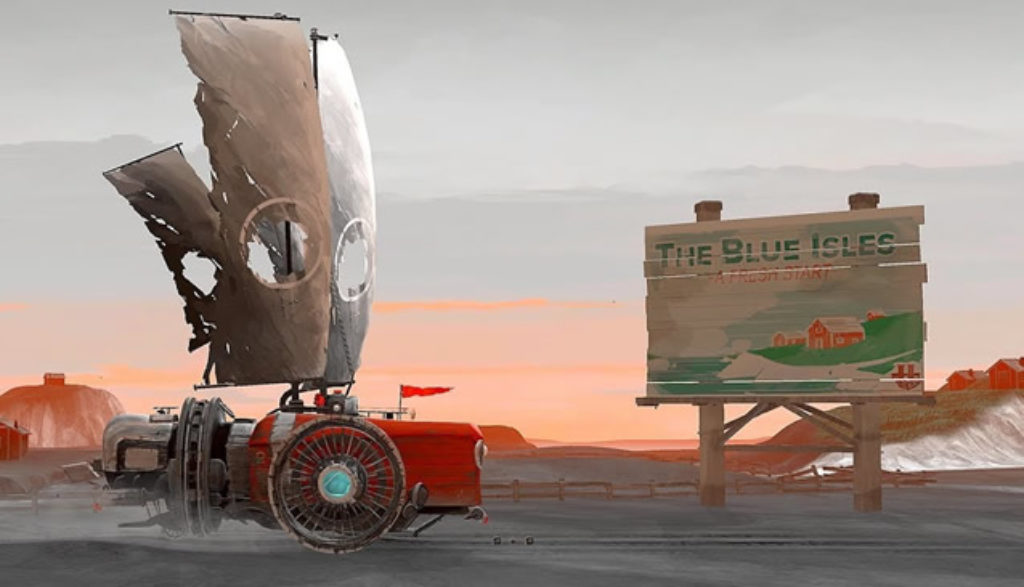
I have a friend who would certainly not call himself a gamer. He dislikes the stress and pressure, the anger and angst, the trigger-pulling and mess of so much of the video gaming universe. But he loves Tetris, an old puzzle game where you stack blocks of blocks, row after row. After a long day at work there’s nothing like a non-threatening game of puzzle-piece shifting and fitting to help my friend unknot and unwind.
Frankly, FAR: Lone Sails, a new “vehicle adventure” indie game from a Swiss company called Okomotive, has almost nothing in common with Tetris. But as I played it, I couldn’t help but sense my muscles unknotting, my mind unwinding, and I really began to understand what my non-gamer friend had meant.
So, what exactly is a vehicle adventure? Well, it’s probably easiest to explain that in the context of this game’s cryptic story. Lone Sails kicks things off with a quiet moment at a gravesite. Who is it that we—in the context of our small-screen avatar—mourn? A lost parent? A sibling? A dear friend? The game never tells us. In fact, the game doesn’t tell us what has come before, why the world around us feels so destitute, who we mourn or where we’re going. But that solemn beginning lets us know it’s going to be an important journey.
Even our little avatar protagonist is a nondescript sort, looking like a jumble of layered cloth. But the big landship we clamber into has plenty of detail. This steampunk wonder—its interior seen through something of a 2-D cross-section view whenever we’re inside—is managed and controlled through a series of big red buttons that we must jump on or thump with our avatar’s head.
And that’s the main gameplay here. We pick up oil cans, wooden crates and other bits of fuel in the outside world of sand, rusted-out vehicles and debris, and feed them into a sort of onboard boiler. Then we hit the proper buttons to keep our rolling mech, uh, rolling. One button sends energy to the engine, another releases pent-up heat for a steam powered boost, another drives an elevator and gives us access to all of the ship’s decks, etc., etc.
There’s no real threat or intensity afoot, except for one short section that features an erupting volcano and flying rocks. No, the real key here is to figure out how to best keep moving in a rhythmic dance of function and purpose and drive your ship forward.
There are fires that must be extinguished, repairs to be made, steam to be vented and ground to be covered. Along the way, we find parts that can be added to our ship to make the going easier: a set of gigantic sails that help save on fuel, for instance, and an attachable vacuum that sucks up boiler-worthy bits of trash. Those additions also add yet another button to push, another area to keep track of.
Oh, and there are also obstacles that block your path: clever physics-based puzzles that must be solved in order to keep trundling through the vast world around you. When you hit these spots, you’ll have to venture forth from the safety of your ship and figure out how to lower this massive set of bridgeworks, how to make it to the tip-top of that colossal metal tower in the dead of night or how to maneuver through a graveyard of gigantic capsized ships.
It’s that oversized world, filled with empty towns, enormous factories, shipyards and scenic vistas, that starts to give you clues about what might have happened in this strange world of metal, gear and steam. And as you stand on the bow of your clunking and chuffing ship-like home and look at that passing world, with all its gray-toned beauty and stillness, that’s when the “unknotting” I mentioned above starts to take place.
Lone Sails is what you make of it. Much like a beautiful painting hanging on a gallery wall, it tells a story. But it’s your story. The game is designed with such a broad, sweeping brush that it allows you to fill in the color and decide what really happened in your tiny protagonist’s great big world.
This game has no monsters to kill. No bad words to spew. No triggers to pull. But for those who want some light puzzle solving in a contemplative world underscored by strings and woodwinds … there’s plenty of smooth sailing to be had.

After spending more than two decades touring, directing, writing and producing for Christian theater and radio (most recently for Adventures in Odyssey, which he still contributes to), Bob joined the Plugged In staff to help us focus more heavily on video games. He is also one of our primary movie reviewers.